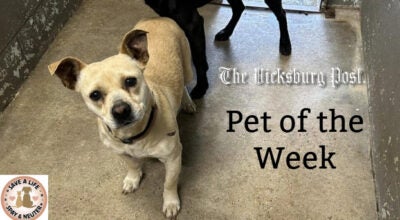WORMS AT WORK: Vermicomposting is easy and offers big rewards
Published 12:42 pm Monday, April 7, 2014
Six worms left in a bucket inspired a project that Peggy McKey of Edwards has shared with school children, Master Gardeners and garden clubs across the state. She tells them all that vermicomposting is easy, not expensive nor time consuming and the rewards are big for those who try this method of enriching soil.
“Vermicomposting is composting aided by red wiggler worms, obtained from friends or a bait store” according to McKey. “Other types of worms do not work well because they cannot endure the changes in pH”.
McKey, A Hinds County Master Gardener, has spoken to hundreds of elementary school children over the last few years and is affectionately known as “The Worm Lady” . She brings in worms and demonstrates how to set up and care for a new worm bin. She brings a dozen or more small plastic containers with an assortment of food products and has the children guess which ones are good to feed the worms. A worm bin takes very little room, is essentially odorless and encourages kids to get interested in nature and gardening.
Adults find her presentation interesting as well particularly after she shares her tomato story. She planted two tomatoes. They were the same size and variety; however, she added vermicompost to one pot and used a popular liquid fertilizer for the other tomato. At the end of the season she realized that she picked more than twice as many tomatoes from the plant that was planted with the addition of the vermicompost. She was sold on worm compost at that point and uses it regularly in her garden. Vermicompost contains more beneficial microbes than traditional compost and is thought to increase a plant’s resistance to fungal disease as well.
“All one needs to create a worm bin is an opaque container, at least 18 gallons such as a plastic storage box with a lid; shredded or torn black and white newspaper, a small bucket of sand or crushed eggshells; kitchen scrapes, grass clippings or leaves; a coffee can of red wigglers and castings, which is the soil medium created by the worms; and water, rainwater or tap water which has been left out overnight so that the chlorine evaporates”.
The worm bin needs to be well-drained and ventilated. A series of holes can be drilled in the lid and the bottom of the container. If insects become a problem, McKey suggests placing a scrap of screen over the holes. If all the worms migrate to the surface, more holes may be needed to let in more air.
The shredded newspaper will create bedding for the worms. It needs to be soaked in the chlorine free water for just a short time, then drained and wrung out, fluffed and then placed in the bottom of the tub. The bin should be filled about 1/2 to 2/3 full with damp shredded paper. A cup of sand or crushed eggshells is sprinkled over the paper then leaf litter which is the natural habitat of these worms.
“Worms do not have teeth” McKey states “so the sand or egg shells provide them with something gritty to help them grind up their food”.
Food scraps come next. Worms are strictly vegetarian so no meat, eggs or fats should ever be added to a worm bin. According to McKey, they like all fruit and vegetables (peelings and cores as well as the over-ripe or rotten that generally gets thrown away), coffee grounds with the filter, tea bags, bread, pizza crust, cereal (stale or moldy), used paper napkins and plates, egg shells, shredded or torn paper (not colored or glossy), leaves, hay and grass clippings (no chemicals added). One pound of red wigglers will eat approximately 3 ½ pounds of food scraps per weeks according to Beth Huxta in an article in the April/May 2014 edition of Organic Gardening Magazine. A video is available on their website:
OrganicGardening.com/worms demonstrating how to build a worm bin with troubleshooting tips.
The worms and casings are added after the scraps. Sheets of damp newspaper can be placed over the worms to hold in moisture. Then the top goes on the container. Worms like it dark. They can be keep inside or outside but avoid placing them in direct sunshine. McKey uses an old horse trough as her bin with a piece of plywood as a cover and keeps it in the barn on her rural property.
McKey keeps a small bucket for kitchen scraps in her kitchen and goes out periodically to bury the scraps under the bedding in the worm bin so as not to attract bugs. If the soil gets soggy, the top can be removed on a clear day so some of the water will evaporate. Worms breathe through their skin and cannot breathe adequately in very wet soil.
“It usually takes about three months for the worms to compost all the newspaper bedding and scraps. Harvesting the compost is easy. I open the top and the light drives them deeper in the compost after a couple of days. I move all the material in the bin to one side and place fresh bedding and some of their favorite food on the other side to draw them over to search for food. My worms really like melon rinds and squash” McKey states.
It may take several weeks for them all to move into the new side. The compost can be scooped out and any stragglers can be left in the compost that goes into a garden bed or pot or returned to the fresh bedding. That may depend on whether a gardener is queasy or comfortable actually touching them!
There are also pre-fabricated worm bins available on the internet: cleanairgardening.com (214-819-9500) and gardeners.com (888-833-1412). McKey says that the vermicomposting can also be done on the ground or in a pit. Whatever method one prefers, the compost is great to amend soil for both indoor and outdoor plants. One part vermicompost to three or four parts soilless mix is ideal for containers and a scoop in each planting hole in a garden is an excellent way to get a new plant started or just use it to topdress established plants.
•
Miriam Jabour, a Master Gardener and Master Flower Show judge, has been active in the Openwood Plantation Garden Club for over 35 years. Write to her at 1114 Windy Lake Drive, Vicksburg MS 39183.







